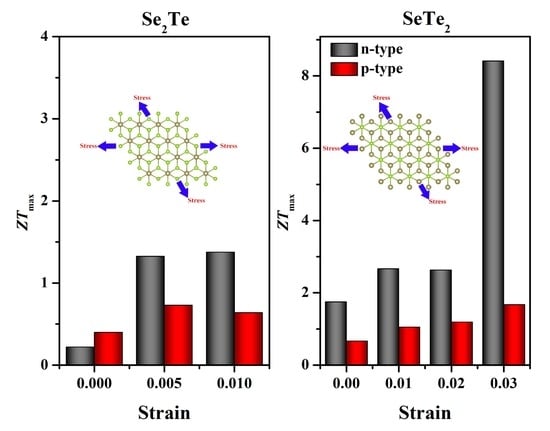Biaxial Tensile Strain-Induced Enhancement of Thermoelectric Efficiency of α-Phase Se2Te and SeTe2 Monolayers
Abstract
:1. Introduction
2. Theoretical Methods and Computational Details
3. Results and Discussion
3.1. Stability and Electronic Properties
3.2. Electronic Transport Property
3.3. Lattice Thermal Conductivity
3.4. Figure of Merit
4. Conclusions
Supplementary Materials
Author Contributions
Funding
Institutional Review Board Statement
Informed Consent Statement
Data Availability Statement
Conflicts of Interest
References
- Zhang, X.; Zhao, L.D. Thermoelectric materials: Energy conversion between heat and electricity. J. Materiomics 2015, 1, 92–105. [Google Scholar] [CrossRef] [Green Version]
- Bell, L.E. Cooling, heating, generating power, and recovering waste heat with thermoelectric systems. Science 2008, 321, 1457–1461. [Google Scholar] [CrossRef] [Green Version]
- Ouyang, Y.; Zhang, Z.; Li, D.; Chen, J.; Zhang, G. Emerging Theory, Materials, and Screening Methods: New Opportunities for Promoting Thermoelectric Performance. Ann. Der Phys. 2019, 531, 1800437. [Google Scholar] [CrossRef] [Green Version]
- Zhu, Z.L.; Cai, X.L.; Yi, S.H.; Chen, J.L.; Dai, Y.W.; Niu, C.Y.; Guo, Z.X.; Xie, M.H.; Liu, F.; Cho, J.H.; et al. Multivalency-driven formation of Te-based monolayer materials: A combined first-principles and experimental study. Phys. Rev. Lett. 2017, 119, 5. [Google Scholar] [CrossRef] [PubMed] [Green Version]
- Chen, J.; Dai, Y.; Ma, Y.; Dai, X.; Ho, W.; Xie, M. Ultrathin beta-tellurium layers grown on highly oriented pyrolytic graphite by molecular-beam epitaxy. Nanoscale 2017, 9, 15945–15948. [Google Scholar] [CrossRef] [Green Version]
- Lin, Z.Y.; Wang, C.; Chai, Y. Emerging Group-VI Elemental 2D Materials: Preparations, Properties, and Device Applications. Small 2020, 16, 16. [Google Scholar] [CrossRef]
- Chen, S.; Tao, W.; Zhou, Y.; Zeng, Z.; Chen, X.; Geng, H. Novel thermoelectric performance of 2D 1T- Se2Te and SeTe2 with ultralow lattice thermal conductivity but high carrier mobility. Nanotechnology 2021, 32, 455401. [Google Scholar] [CrossRef] [PubMed]
- Zhong, X.; Huang, Y.; Yang, X. Superior thermoelectric performance of α-Se2Te monolayer. Mater. Res. Express 2021, 8, 045507. [Google Scholar] [CrossRef]
- Liu, Y.; Wu, W.; Goddard, W.A. Tellurium: Fast Electrical and Atomic Transport along the Weak Interaction Direction. J. Am. Chem. Soc. 2018, 140, 550–553. [Google Scholar] [CrossRef] [Green Version]
- Ramírez-Montes, L.; López-Pérez, W.; González-Hernández, R.; Pinilla, C. Large thermoelectric figure of merit in hexagonal phase of 2D selenium and tellurium. Int. J. Quantum Chem. 2020, 120, 26267. [Google Scholar] [CrossRef]
- Gao, Z.; Tao, F.; Ren, J. Unusually low thermal conductivity of atomically thin 2D tellurium. Nanoscale 2018, 10, 12997–13003. [Google Scholar] [CrossRef] [Green Version]
- Sharma, M. Stability, Tunneling Characteristics and Thermoelectric Properties of TeSe2 allotropes. arXiv 2020, arXiv:2012.03871. [Google Scholar]
- Lv, H.Y.; Lu, W.J.; Shao, D.F.; Lu, H.Y.; Sun, Y.P. Strain-induced enhancement in the thermoelectric performance of a ZrS2 monolayer. J. Mater. Chem. C 2016, 4, 4538–4545. [Google Scholar] [CrossRef] [Green Version]
- Guo, S.-D. Biaxial strain tuned thermoelectric properties in monolayer PtSe2. J. Mater. Chem. C 2016, 4, 9366–9374. [Google Scholar] [CrossRef]
- D’Souza, R.; Mukherjee, S.; Ahmad, S. Strain induced large enhancement of thermoelectric figure-of-merit (ZT similar to 2) in transition metal dichalcogenide monolayers ZrX2 (X = S, Se, Te). J. Appl. Phys. 2019, 126, 214302. [Google Scholar] [CrossRef] [Green Version]
- Wang, N.; Li, M.; Xiao, H.; Gong, H.; Liu, Z.; Zu, X.; Qiao, L. Optimizing the thermoelectric transport properties of Bi2O2Se monolayer via biaxial strain. Phys. Chem. Chem. Phys. 2019, 21, 15097–15105. [Google Scholar] [CrossRef]
- Kresse, G.; Furthmüller, J. Efficient iterative schemes for ab initio total-energy calculations using a plane-wave basis set. Phys. Rev. B 1996, 54, 11169–11186. [Google Scholar] [CrossRef] [PubMed]
- Kresse, G.; Furthmüller, J. Efficiency of ab-initio total energy calculations for metals and semiconductors using a plane-wave basis set. Comp. Mater. Sci. 1996, 6, 15–50. [Google Scholar] [CrossRef]
- Perdew, J.P.; Burke, K.; Ernzerhof, M. Generalized Gradient Approximation Made Simple. Phys. Rev. Lett. 1996, 77, 3865–3868. [Google Scholar] [CrossRef] [PubMed] [Green Version]
- Eglitis, R.I.; Purans, J.; Jia, R. Comparative Hybrid Hartree-Fock-DFT Calculations of WO2-Terminated Cubic WO3 as Well as SrTiO3, BaTiO3, PbTiO3 and CaTiO3 (001) Surfaces. Crystals 2021, 11, 455. [Google Scholar] [CrossRef]
- Eglitis, R.I.; Purans, J.; Popov, A.I.; Jia, R. Tendencies in ABO3 Perovskite and SrF2, BaF2 and CaF2 Bulk and Surface F-Center Ab Initio Computations at High Symmetry Cubic Structure. Symmetry 2021, 13, 1920. [Google Scholar] [CrossRef]
- Li, X.; Zhang, Z.; Xi, J.; Singh, D.J.; Sheng, Y.; Yang, J.; Zhang, W. TransOpt. A code to solve electrical transport properties of semiconductors in constant electron-phonon coupling approximation. Comp. Mater. Sci. 2021, 186, 110074. [Google Scholar] [CrossRef]
- Ding, J.; Liu, C.; Xi, L.; Xi, J.; Yang, J. Thermoelectric transport properties in chalcogenides ZnX (X = S, Se): From the role of electron-phonon couplings. J. Materiomics 2021, 7, 310–319. [Google Scholar] [CrossRef]
- Sheng, Y.; Wu, Y.; Yang, J.; Lu, W.; Villars, P.; Zhang, W. Active learning for the power factor prediction in diamond-like thermoelectric materials. Npj Comput. Mater. 2020, 6, 171. [Google Scholar] [CrossRef]
- Xi, L.; Pan, S.; Li, X.; Xu, Y.; Ni, J.; Sun, X.; Yang, J.; Luo, J.; Xi, J.; Zhu, W. Discovery of High Performance Thermoelectric Chalcogenides through Reliable High Throughput Material Screening. J. Am. Chem. Soc. 2018, 140, 10785–10793. [Google Scholar] [CrossRef]
- Li, R.; Li, X.; Xi, L.; Yang, J.; Singh, D.J.; Zhang, W. High-Throughput Screening for Advanced Thermoelectric Materials: Diamond-Like ABX2 Compounds. ACS Appl. Mater. Interfaces 2019, 11, 24859–24866. [Google Scholar] [CrossRef]
- Madsen, G.K.H.; Singh, D.J. BoltzTraP. A code for calculating band-structure dependent quantities. Comput. Phys. Commun. 2006, 175, 67–71. [Google Scholar] [CrossRef] [Green Version]
- Madsen, G.K.H.; Carrete, J.; Verstraete, M.J. BoltzTraP2, a program for interpolating band structures and calculating semi-classical transport coefficients. Comput. Phys. Commun. 2018, 231, 140–145. [Google Scholar] [CrossRef] [Green Version]
- Yang, J.; Xi, L.; Qiu, W.; Wu, L.; Shi, X.; Chen, L.; Yang, J.; Zhang, W.; Uher, C.; Singh, D.J. On the tuning of electrical and thermal transport in thermoelectrics: An integrated theory-experiment perspective. Npj Comput. Mater. 2016, 2, 15015. [Google Scholar] [CrossRef] [Green Version]
- Neophytou, N.; Kosina, H. Effects of confinement and orientation on the thermoelectric power factor of silicon nanowires. Phys. Rev. B 2011, 83, 1971–1980. [Google Scholar] [CrossRef] [Green Version]
- Xi, J.Y.; Wang, D.; Yi, Y.P.; Shuai, Z.G. Electron-phonon couplings and carrier mobility in graphynes sheet calculated using the Wannier-interpolation approach. J. Chem. Phys. 2014, 141, 10. [Google Scholar] [CrossRef]
- Xi, J.; Long, M.; Tang, L.; Wang, D.; Shuai, Z. First-principles prediction of charge mobility in carbon and organic nanomaterials. Nanoscale 2012, 4, 4348–4369. [Google Scholar] [CrossRef]
- Togo, A.; Oba, F.; Tanaka, I. First-principles calculations of the ferroelastic transition between rutile-type and CaCl2-type SiO2 at high pressures. Phys. Rev. B 2008, 78, 134106. [Google Scholar] [CrossRef] [Green Version]
- Baroni, S.; De Gironcoli, S.; Corso, D.A.; Gianozzi, P. Phonons and related crystal properties from density-functional perturbation theory. Rev. Mod. Phys. 2001, 73, 515–562. [Google Scholar] [CrossRef] [Green Version]
- Li, W.; Carrete, J.; Katcho, N.A.; Mingo, N. Sheng BTE: A solver of the Boltzmann transport equation for phonons. Comput. Phys. Commun. 2014, 185, 1747–1758. [Google Scholar] [CrossRef]
- Liu, G.; Wang, H.; Li, G.-L. Structures, mobilities, electronic and optical properties of two-dimensional α-phase group-VI binary compounds: α-Se2Te and α-SeTe2. Phys. Lett. A 2020, 384, 126431. [Google Scholar] [CrossRef]
- Kumar, S.; Schwingenschloegl, U. Thermoelectric response of bulk and monolayer MoSe2 and WSe2. Chem. Mater. 2015, 27, 1278–1284. [Google Scholar] [CrossRef]
- Zhu, X.L.; Liu, P.F.; Xie, G.; Zhou, W.X.; Wang, B.T.; Zhang, G. Thermoelectric Properties of Hexagonal M2C3 (M = As, Sb, and Bi) Monolayers from First-Principles Calculations. Nanomaterials 2019, 9, 597. [Google Scholar] [CrossRef] [PubMed] [Green Version]
- Hummer, K.; Grüneis, A.; Kresse, G. Structural and electronic properties of lead chalcogenides from first principles. Phys. Rev. B 2007, 75, 195211. [Google Scholar] [CrossRef]
- Huang, W.; Yang, H.; Cheng, B.; Xue, C. Theoretical study of the bandgap regulation of a two-dimensional GeSn alloy under biaxial strain and uniaxial strain along the armchair direction. Phys. Chem. Chem. Phys. 2018, 20, 23344–23351. [Google Scholar] [CrossRef]
- Guan, X.; Zhu, G.; Wei, X.; Cao, J. Tuning the electronic properties of monolayer MoS2, MoSe2 and MoSSe by applying z-axial strain. Chem. Phys. Lett. 2019, 730, 191–197. [Google Scholar] [CrossRef]
- Becke, A.D.; Edgecombe, K.E. A simple measure of electron localization in atomic and molecular systems. J. Chem. Phys. 1990, 92, 5397–5403. [Google Scholar] [CrossRef]
- Koumpouras, K.; Larsson, J.A. Distinguishing between chemical bonding and physical binding using electron localization function (ELF). J. Phys. Condens. Matter 2020, 32, 315502. [Google Scholar] [CrossRef] [PubMed]
- Steinmann, S.N.; Mo, Y.; Corminboeuf, C. How do electron localization functions describe π-electron delocalization? Phys. Chem. Chem. Phys. 2011, 13, 20584–20592. [Google Scholar] [CrossRef]
- Page, Y.L.; Saxe, P. Symmetry-general least-squares extraction of elastic data for strained materials from ab initio calculations of stress. Phys. Rev. B 2002, 65, 104104. [Google Scholar] [CrossRef]
- Blonsky, M.N.; Zhuang, H.L.; Singh, A.K.; Hennig, R.G. Ab initio prediction of piezoelectricity in two-dimensional materials. ACS Nano 2015, 9, 9885–9891. [Google Scholar] [CrossRef]
- Alyörük, M.M.; Aierken, Y.; Çakır, D.; Peeters, F.M.; Sevik, C. Promising piezoelectric performance of single layer transition-metal dichalcogenides and dioxides. J. Phys. Chem. C 2015, 119, 23231–23237. [Google Scholar] [CrossRef]
- Çakır, D.; Peeters, F.M.; Sevik, C. Mechanical and thermal properties of h-MX2 (M = Cr, Mo, W; X = O, S, Se, Te) monolayers: A comparative study. Appl. Phys. Lett. 2014, 104, 203110. [Google Scholar] [CrossRef]
- Yin, H.; Gao, J.; Zheng, G.; Wang, Y.; Ma, Y. Giant Piezoelectric Effects in Monolayer Group-V Binary Compounds with Honeycomb Phases: A First-Principles Prediction. J. Mater. Chem. C 2017, 121, 25576–25584. [Google Scholar] [CrossRef]
- Zhu, X.-L.; Hou, C.-H.; Zhang, P.; Liu, P.-F.; Xie, G.; Wang, B.-T. High thermoelectric performance of new two-dimensional IV–VI compounds: A first-principles study. J. Phys. Chem. C 2020, 124, 1812–1819. [Google Scholar] [CrossRef]
- Spitzer, D.P. Lattice thermal conductivity of semiconductors: A chemical bond approach. J. Phys. Chem. Solids 1970, 31, 19–40. [Google Scholar] [CrossRef]
- Feng, Z.; Fu, Y.; Zhang, Y.; Singh, D.J. Characterization of rattling in relation to thermal conductivity: Ordered half-Heusler semiconductors. Phys. Rev. B 2020, 101, 064301. [Google Scholar] [CrossRef] [Green Version]
- Muthaiah, R.; Tarannum, F.; Garg, J. Strain tuned low thermal conductivity in Indium Antimonide (InSb) through increase in anharmonic phonon scattering-A first-principles study. Solid State Commun. 2021, 334-335, 114378. [Google Scholar] [CrossRef]
- Peng, B.; Zhang, H.; Shao, H.; Xu, Y.; Zhang, X.; Zhu, H. Low lattice thermal conductivity of stanene. Sci. Rep. 2016, 6, 20225. [Google Scholar] [CrossRef] [Green Version]
- Shafique, A.; Samad, A.; Shin, Y.-H. Ultra low lattice thermal conductivity and high carrier mobility of monolayer SnS2 and SnSe2: A first principles study. Phys. Chem. Chem. Phys. 2017, 19, 20677–20683. [Google Scholar] [CrossRef] [PubMed]
- Qin, G.; Qin, Z.; Fang, W.Z.; Zhang, L.C.; Su, G. Diverse anisotropy of phonon transport in two-dimensional IV-VI compounds: A comparative study. Nanoscale 2016, 8, 11306. [Google Scholar] [CrossRef] [Green Version]
- Ma, J.; Meng, F.; He, J.; Jia, Y.; Li, W. Strain-Induced Ultrahigh Electron Mobility and Thermoelectric Figure of Merit in Monolayer α-Te. ACS Appl. Mater. Interfaces 2020, 12, 43901–43910. [Google Scholar] [CrossRef]
- Wang, Y.; Gao, Z.B.; Zhou, J. Ultralow lattice thermal conductivity and electronic properties of monolayer 1T phase semimetal SiTe2 and SnTe2. Physica E 2019, 108, 53–59. [Google Scholar] [CrossRef] [Green Version]
- Zhao, L.D.; Lo, S.H.; Zhang, Y.; Sun, H.; Tan, G.; Uher, C.; Wolverton, C.; Dravid, V.P.; Kanatzidis, M.G. Ultralow thermal conductivity and high thermoelectric figure of merit in SnSe crystals. Nature 2014, 508, 373–377. [Google Scholar] [CrossRef]
- Lou, X.; Li, S.; Chen, X.; Zhang, Q.; Deng, H.; Zhang, J.; Li, D.; Zhang, X.; Zhang, Y.; Zeng, H.; et al. Lattice Strain Leads to High Thermoelectric Performance in Polycrystalline SnSe. ACS Nano 2021, 15, 8204–8215. [Google Scholar] [CrossRef]
- Cicek, M.M.; Demirtas, M.; Durgun, E. Tuning thermoelectric efficiency of monolayer indium nitride by mechanical strain. J. Appl. Phys. 2021, 129, 234302. [Google Scholar] [CrossRef]


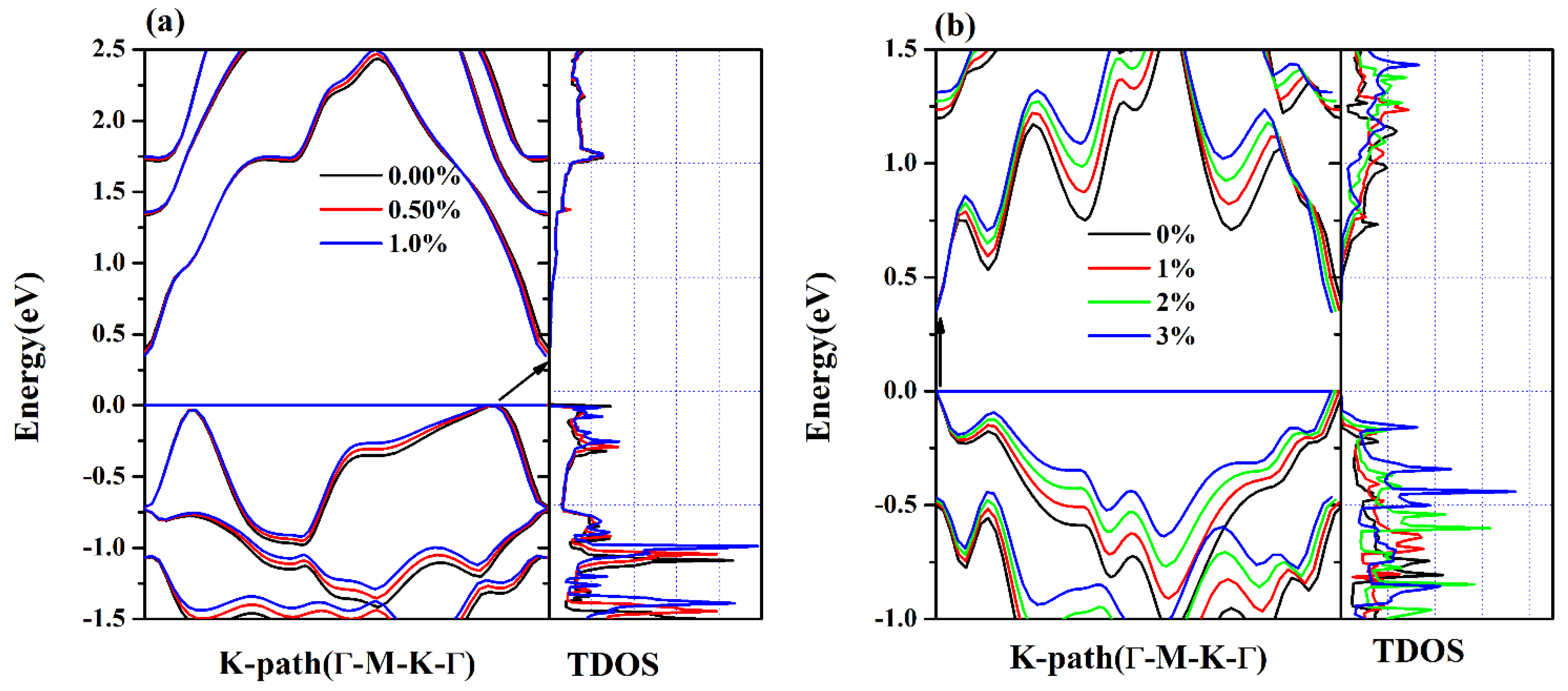
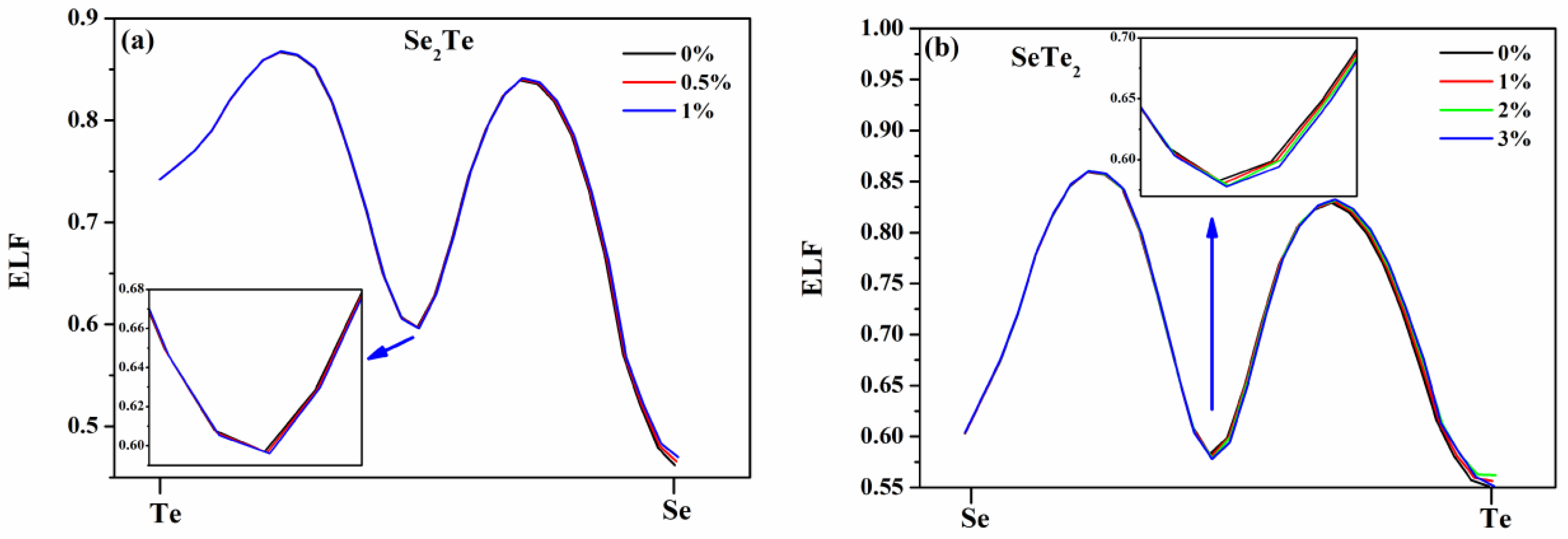
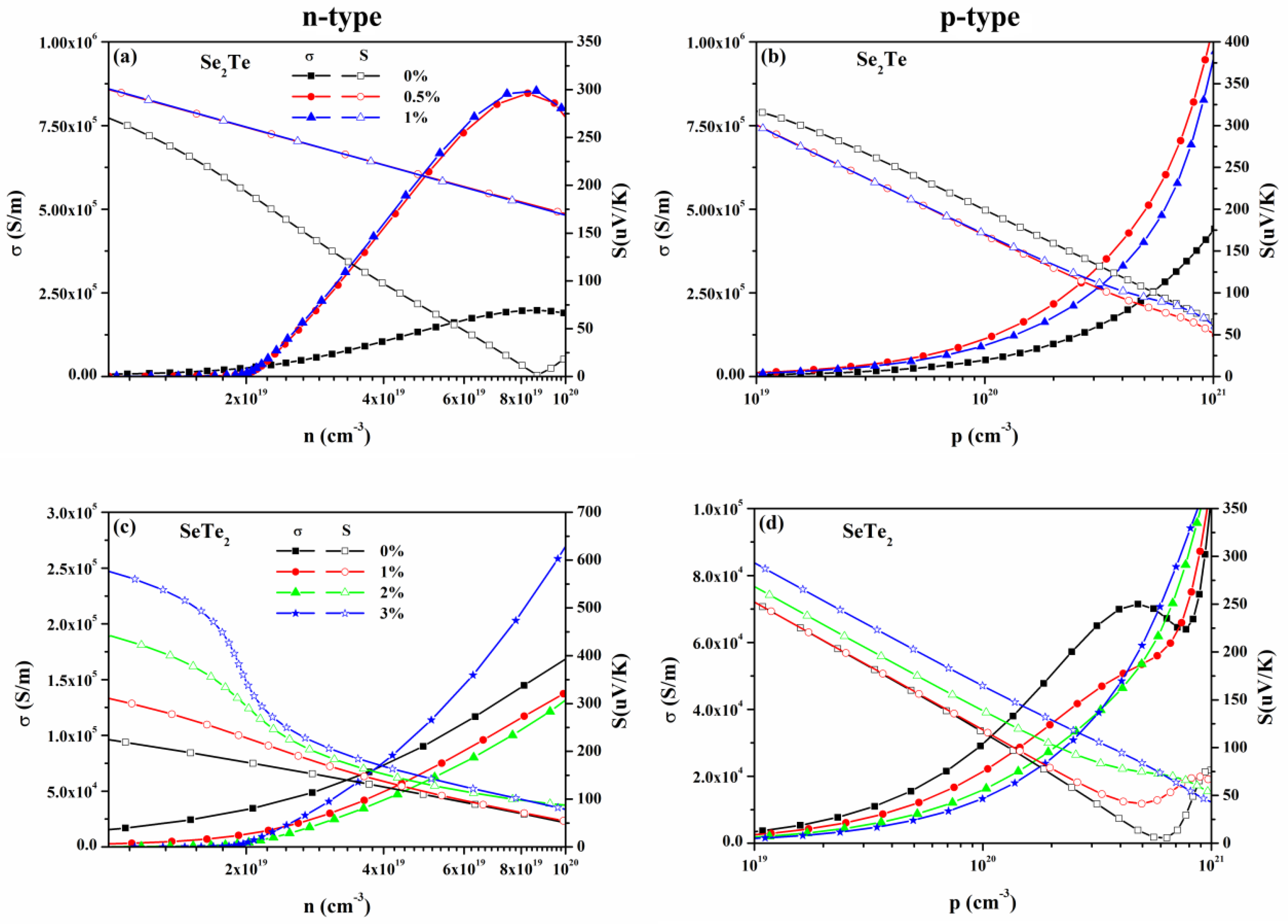
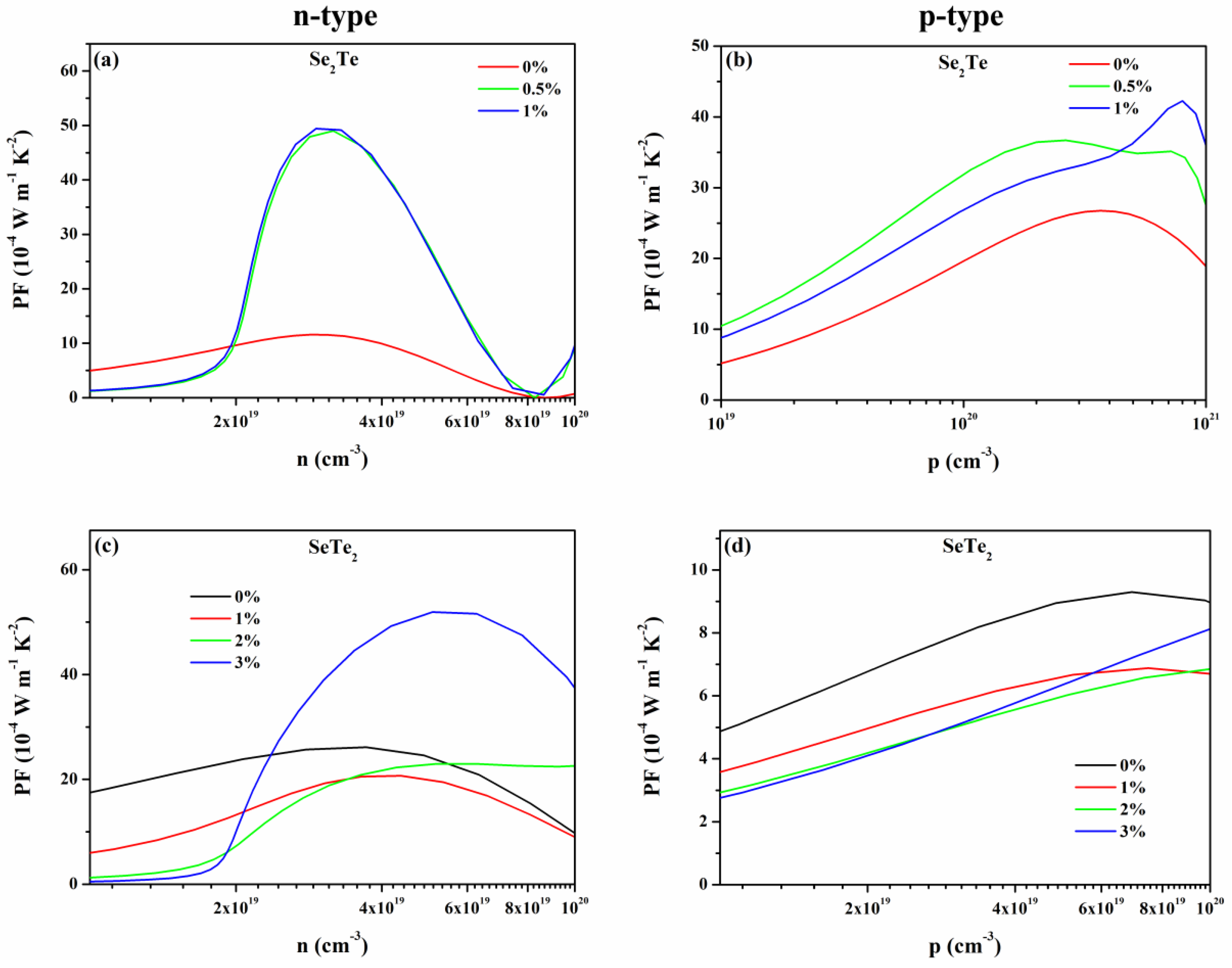
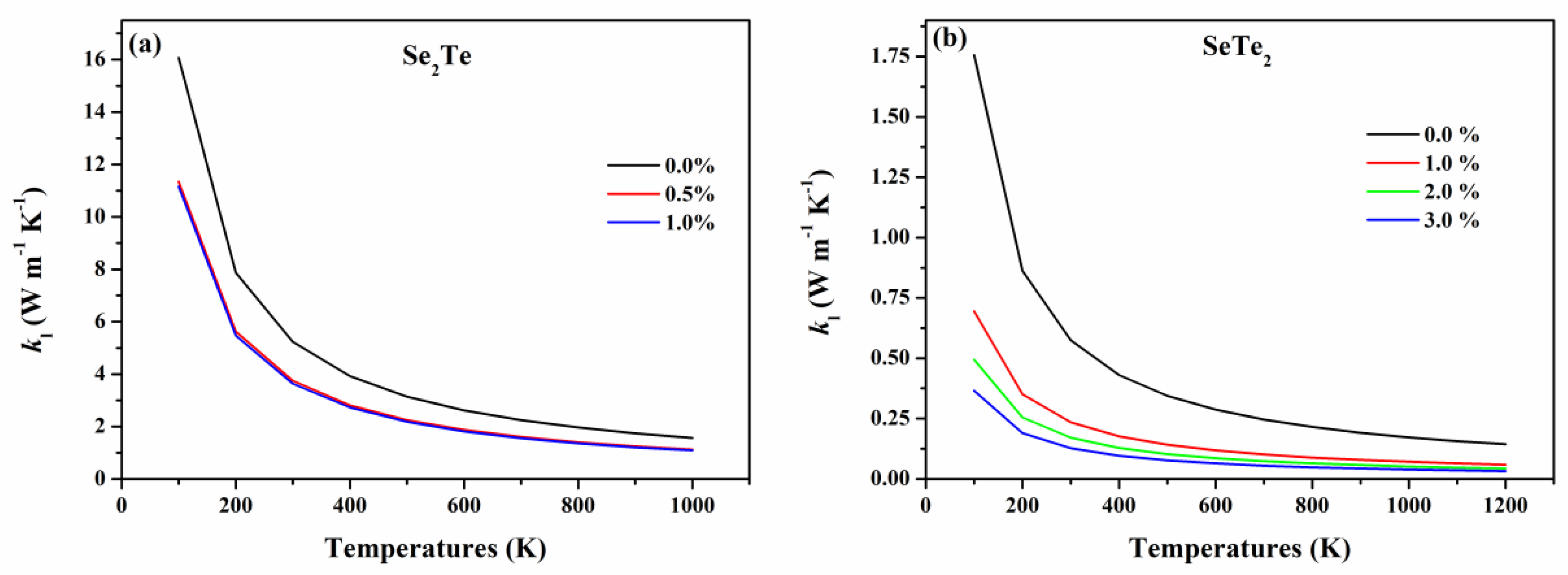
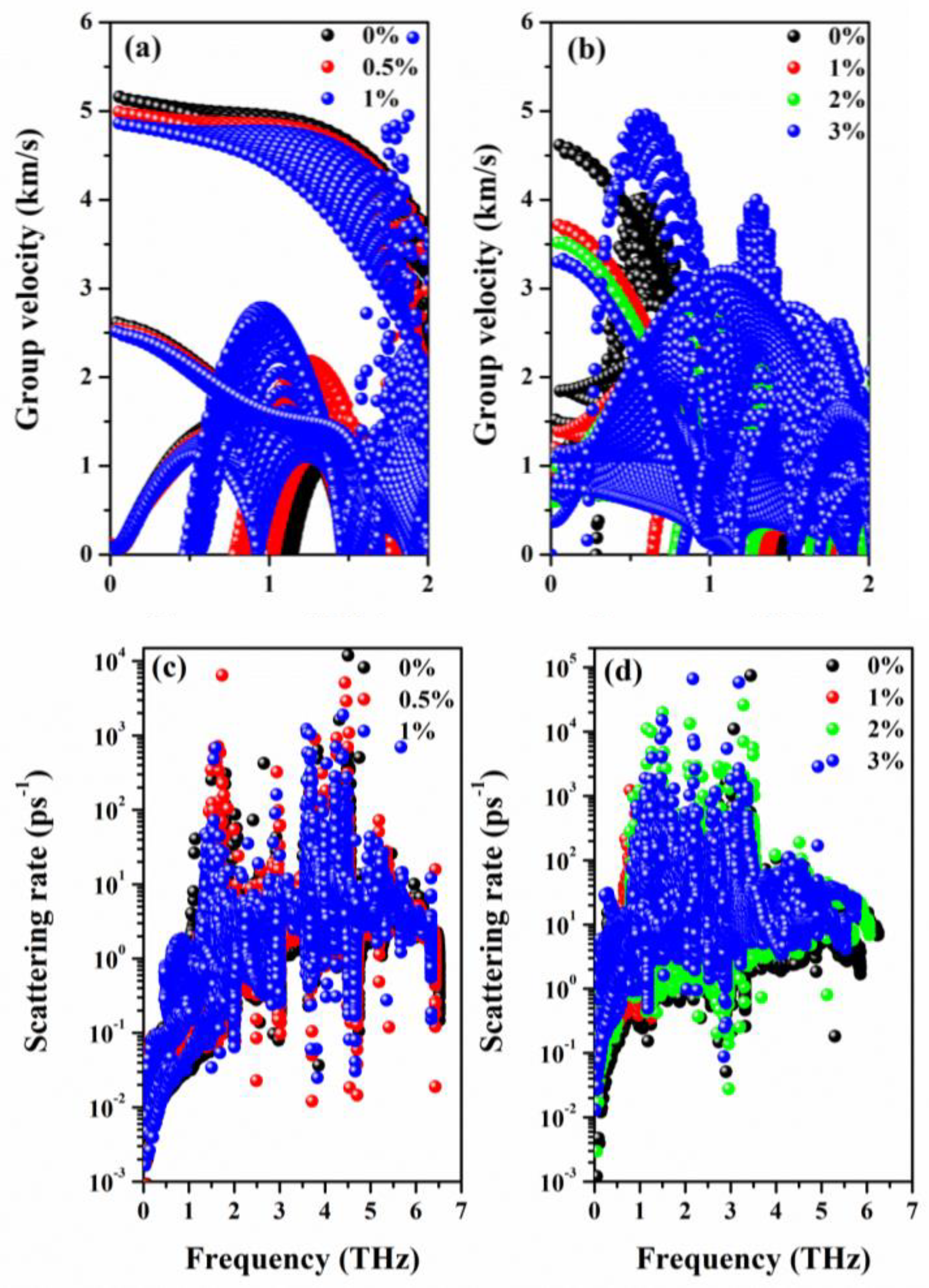
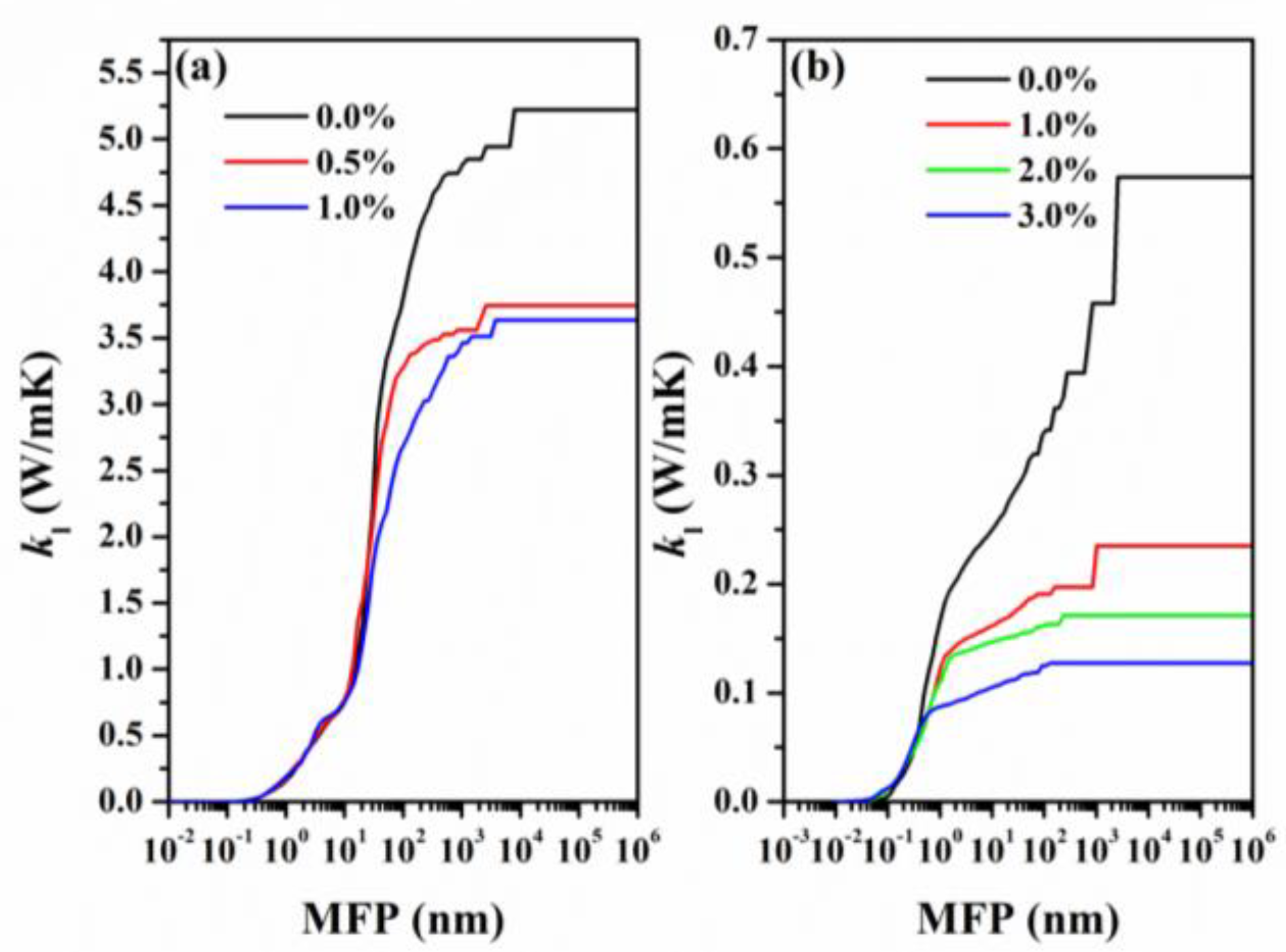

| Strain | ElVBM (eV) | ElCBM (eV) | Y (GPa) | C2D (N/m) | Eg (eV) | |
|---|---|---|---|---|---|---|
| Se2Te | 0% | −5.086 | −6.744 | 126.545 | 44.016 | 0.395 |
| −4.196 a | −6.676 a | 43.64 a | 0.38 a | |||
| 0.5% | −4.834 | −6.552 | 123.247 | 42.547 | 0.373 | |
| 1% | −5.011 | −6.512 | 120.317 | 41.178 | 0.351 | |
| SeTe2 | 0% | −6.316 | −6.446 | 103.340 | 37.538 | 0.363 |
| 6.590 a | 6.620 a | 36.19 a | 0.33 a | |||
| 1% | −6.098 | −6.272 | 97.101 | 34.847 | 0.359 | |
| 2% | −5.782 | −5.956 | 91.257 | 31.590 | 0.354 | |
| 3% | −5.568 | −5.716 | 85.594 | 30.380 | 0.350 |
| Compounds | Strain | ZA | TA | LA | Optical | kl (W m−1 K−1) |
|---|---|---|---|---|---|---|
| Se2Te | 0% | 17.73% 19.28% [8] | 51.32% 43.12% [8] | 23.65% 28% [8] | 7.30% 9.29% [8] | 5.236 4.88 [8] |
| 0.5% | 18.28% | 36.63% | 35.50% | 9.59% | 3.744 | |
| 1% | 21.90% | 56.45% | 14.14% | 7.52% | 3.636 | |
| SeTe2 | 0% | 11.49% | 6.33% | 65.42% | 16.76% | 0.574 |
| 1% | 14.98% | 10.59% | 48.23% | 26.20% | 0.235 | |
| 2% | 12.96% | 17.96% | 37.62% | 31.46% | 0.171 | |
| 3% | 14.74% | 20.54% | 32.85% | 31.86% | 0.128 |
Publisher’s Note: MDPI stays neutral with regard to jurisdictional claims in published maps and institutional affiliations. |
© 2021 by the authors. Licensee MDPI, Basel, Switzerland. This article is an open access article distributed under the terms and conditions of the Creative Commons Attribution (CC BY) license (https://creativecommons.org/licenses/by/4.0/).
Share and Cite
Chen, S.-B.; Liu, G.; Yan, W.-J.; Hu, C.-E.; Chen, X.-R.; Geng, H.-Y. Biaxial Tensile Strain-Induced Enhancement of Thermoelectric Efficiency of α-Phase Se2Te and SeTe2 Monolayers. Nanomaterials 2022, 12, 40. https://doi.org/10.3390/nano12010040
Chen S-B, Liu G, Yan W-J, Hu C-E, Chen X-R, Geng H-Y. Biaxial Tensile Strain-Induced Enhancement of Thermoelectric Efficiency of α-Phase Se2Te and SeTe2 Monolayers. Nanomaterials. 2022; 12(1):40. https://doi.org/10.3390/nano12010040
Chicago/Turabian StyleChen, Shao-Bo, Gang Liu, Wan-Jun Yan, Cui-E Hu, Xiang-Rong Chen, and Hua-Yun Geng. 2022. "Biaxial Tensile Strain-Induced Enhancement of Thermoelectric Efficiency of α-Phase Se2Te and SeTe2 Monolayers" Nanomaterials 12, no. 1: 40. https://doi.org/10.3390/nano12010040
APA StyleChen, S.-B., Liu, G., Yan, W.-J., Hu, C.-E., Chen, X.-R., & Geng, H.-Y. (2022). Biaxial Tensile Strain-Induced Enhancement of Thermoelectric Efficiency of α-Phase Se2Te and SeTe2 Monolayers. Nanomaterials, 12(1), 40. https://doi.org/10.3390/nano12010040






